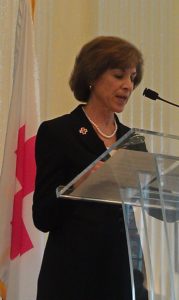Today the Red Cross is proudly hosting the White House forum on nonprofit leadership at our headquarters building in Washington, D.C. I had the honor of welcoming about two hundred guests to the event this morning in our Hall of service, where 100 years ago women volunteers rolled bandages for wounded soldiers during World War I.
Participants at the day-long dialogue will discuss the important role of nonprofit organizations and how to develop leadership within the sector to drive the expansion of community-based solutions to our nation’s most pressing social problems and create jobs. The nation’s 1.6 million nonprofit organizations employ 13.5 million workers, nearly 10% of the American workforce.
Co-conveners include The Annie E. Casey Foundation, The Aspen Institute Program on Philanthropy and Social Innovation, Center for Creative Leadership, Commongood Careers, Independent Sector, Public Allies and American Express.
I believe my road to the Red Cross illustrates an important lesson for future leaders in the nonprofit sector. What drew me to the American Red Cross after 28 years in the private sector was a desire to help a national treasure deal with a series of challenges, the most glaring of which was a $209 million deficit and a mountain of debt.
I walked in to the job with a preconceived notion that the Red Cross could simply benefit from some private sector-like leadership. But in truth, I was only half right.
We did deploy many of the techniques and initiatives that the for-profit sector would recognize and employ. We eliminated our deficit within two years and have actually delivered a surplus for the last two years in a row. We paid down some of our debt as well as consolidated back-office operations and centralized procurement. Today, we’re ten percent smaller than we were 6 months ago, and last fiscal year, 92 cents of every dollar went to the people we served.
These changes were necessary, but certainly not easy. We lost many of our valuable employees in process. However, none of these actions impacted our ability to deliver our mission. And let me tell you, we were tested by anything Mother Nature could throw at us—floods, hurricanes, earthquakes, tornados and wild fires.
But here’s what I found so humbling: Red Crossers, and I dare say most people who work or volunteer in the independent sector, will do virtually anything to forward our mission.
They are here because of their innate nature to want to give back, to serve others and to be a part of something greater than themselves. When you explain to a Red Crosser that what you’re doing will forward the mission and make us even better stewards of our donors’ dollars, they actually become change agents. I’ve never experienced anything like this in the for-profit world.
As a leader, I’ve learned that leading from your heart as well as your head is more gratifying and fulfilling. It’s the nature of every employee and volunteer in our sector to be mission-driven. As we seek to invest in building capable leaders in the nonprofit industry, we need to learn to harness our employees’ desire to make a difference and use it to achieve our mission.
At the risk of sounding corny, tapping into the need that so many of us have to make a difference, will not only help our sector flourish, it will make the world a better place. Investing in talent, leadership, diversity, and our human capital will help nonprofits better serve our neighbors in the long-run.

